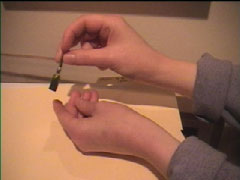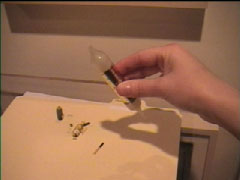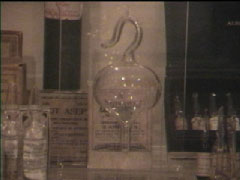click to enlarge
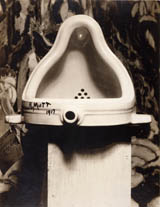
Marcel Duchamp,Fountain,
1917 © 2000 Succession Marcel
Duchamp ARS, N.Y./ADAGP, Paris

Marcel Duchamp,Trébuche
t (Trap), 1917 © 2000 Succession
Marcel Duchamp ARS,
N.Y./ADAGP, Paris.

Marcel Duchamp,
Hat Rack, 1917
© 2000 Succession
Marcel Duchamp ARS,
N.Y./ADAGP, Paris.
We truly appreciate the effort that you made to research the historical context for Duchamp’s alleged “Paris Air Medical Ampule.”
Despite Duchamp’s contention that his objects were mass-produced readymades, the fact remains that no exact duplicate exists for any of his productions in the historical record. No scholar has ever found — in any museum catalogue or collection, or dealers’ storerooms — any exact object (urinal, coatrack, hatrack, etc.) that, according to Duchamp’s claims, was mass produced, store bought and readymade. Is this not strange? If an object is mass produced, by definition and logic, the attempt to find a duplicate design should not be analogous to searching for a needle in a haystack or scraping the bottom of a barrel, as has been the case.
So little evidence exists for the art historical othodoxy’s assumption — namely, that readymades are mass produced, and were therefore readily found in stores. Therefore, a reversal of the typical question of evidence about the status of Duchamp’s objects must be proposed. We should be persuaded by, and judge only by, direct evidence any claim that Duchamp objects are, in fact, readymade.
Using three illustrations of infusion devises, your letter lists three criteria met by Duchamp’s ampule in your judgement.
1. A closed vessel for sterilization
2.It can be used as an infusion system (with a bottom to break for connection to a tube)
3.”Convenient apparatus to hang over the patient’s bed because of the glass hook”
Yet when I look at your three illustrations, I fail to follow your conclusion that the Paris Air ampule “combines all three functions in one piece made of the same uniform material.”
Figure 1 does not have a glass hook and, like Figure 2, is safely and securely held by a metal clasp. Therefore the hook and the ampule are separate, not uniform materials as in Duchamp’s ampules. Indeed, Figure 3 is very suggestive — but unlike Figure 1 and 2, which appear to be accurate technical drawings from medical catalogues, Figure 3 with its inclusion of a hanging curtain and rough, hand-drawn quality is unclear. Considering Figure 3‘s earlier 19th century date, this device was replaced by more practical and safe designs shown inFigure 1 and 2. The cylinder form of Figure 2 shares, with the mass-produced ampules developed in France during the first years of the 20th century, a shape that can be safely packed into boxed rows (see my Illustration A of an early 20th century ampule mass-production factory).
click to enlarge
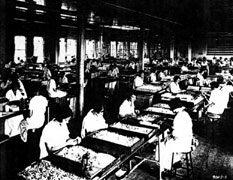
Illustration A
Photograph showing a
factory mass-producing ampules,
France, early 20th century
I have handled many European and American ampules and have “opened” them (see video). It would have been very tricky to attach a hose to the jagged end of an ampule. If indeed a glass hook was ever incorporated (as Figure 3 is unclear), the motion of a patient’s arm would have led to stress on a glass hook that would likely cause it to break or become dislodged. Logic and practicality would lead to the further development of a metal, not a glass hook — as shown by the historical chronology held within your illustrations, beginning with Figure 3, then Figure 1, and Figure 2 as the most historically recent in the series.
But let’s say that you are correct and that Figure 3 was among the early experiments in hand-made infusion devises that Duchamp saw hanging in a pharmacy as an “old pharmaceutical/medical instrument for decoration” (as you write). Is this one-of-a kind and obsolete hand-made infusion ampule to be accepted by us as evidence of Duchamp’s use of a mass produced, easily found, store-bought readymade object?
As to size, I believe that the facts about sizes of infusion balls actually used and made would be extremely important to know. For example, what if infusion ampules — even early custom-made ones — were only more than 125 cc in volume? This fact would further indicate that Duchamp had his own ampule made. Or on the contrary, if you discovered that infusion ball ampules were only made in 35 cc and 125 cc in volume, this would suggest that Duchamp exploited the two standard sizes for his original 1919 and 1941 Boite en Valiseversions, etc. Furthermore, we have testimony by experts that a pharmacist would not have needed unusual skills to convert a mass-produced ampule into a custom-made version similar to Duchamp’s larger 1919 and smaller 1941 Paris Air objects. In fact, Duchamp tells us that he had his 1941 ampules version custom made.
- Click image for video (QT 2.6MB)
- Click image for video (QT 2.6MB)
- Click image for video (QT 2.0MB)
- Demonstration of the
breaking of two antique
ampules at the Art Science
Research Laboratory, NY - More contemporary ampule
(with thicker glass) - Display of various antique
ampules at ASRL, NY
I believe that the question of Duchamp’s readymade ampule is very much aided by your research, but must still continue! I would love to find out more about infusion devices. If, in fact, infusion balls were “available in a great variety of sizes for different medical indications,” evidence and images of mass-produced infusion balls matching Duchamp’s Paris Air (1919) should readily be found, and should now be in the historical record in a duplicate form, not just as resemblances. A duplicate of Paris Air (1919) (alas, for people who want to believe in readymades) has not yet been found. We may be facing another Loch Ness monster or Big Foot. People will believe that Duchamp’s Paris Air (1919) ampule was a mass-produced readymade even in the face of little or no evidence.



